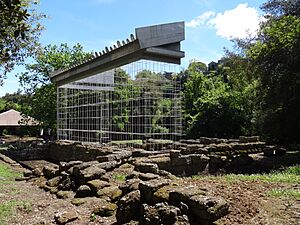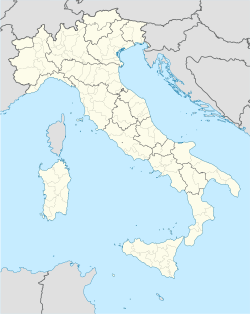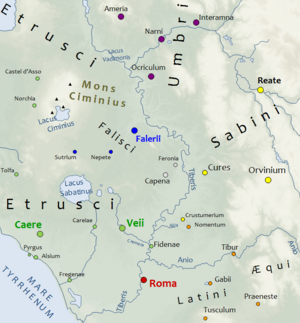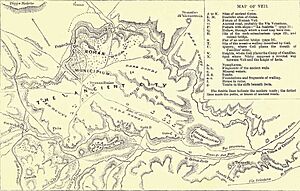Veii facts for kids
|
Veio
|
|

Ruins of the temple of Veii
|
|
| Alternative name | Veius |
|---|---|
| Location | Isola Farnese, Province of Rome, Lazio, Italy |
| Region | Latium |
| Coordinates | 42°01′24″N 12°23′23″E / 42.02333°N 12.38972°E |
| Type | Settlement |
| Area | 190 ha (470 acres) |
| History | |
| Events | Battle of Veii |
| Site notes | |
| Condition | Ruined |
| Ownership | Public |
| Management | Soprintendenza per i Beni Archeologici dell'Etruria Meridionale |
| Public access | Yes |
| Website | Area archeologica di Veio |
Veii (also called Veius; Italian: Veio) was a very important ancient Etruscan city. It was located in southern Etruria, about 16 kilometers (10 miles) north of Rome, Italy. Today, the site is in Isola Farnese, which is part of the city of Rome. Other nearby places, like Formello, were also part of Veii's territory.
Veii was the richest city in the Etruscan League. For over 300 years, it was sometimes at war and sometimes allied with the Roman Kingdom and later the Republic. Eventually, the Roman general Camillus captured Veii in the Battle of Veii in 396 BC. Even after the Romans took over, people continued to live there.
Now, the area is a protected park called Parco di Veio, created in 1997.
Contents
Exploring Ancient Veii
The city of Veii was built mostly on a flat-topped hill made of soft rock called tuff. This area covered about 190 hectares (470 acres).
The City's Location
The Valchetta stream flows a few miles east from Veii to join the Tiber River. Veii's land included this area near the Tiber. Being close to the Tiber River was great for trade. This river was part of a trade route that later became the Via Flaminia, a famous Roman road. This helped Veii become very wealthy.
The people of Veii traded with ancient Greece and the Phoenicians. Many pieces of Greek pottery have been found at Veii, some dating back to the 8th century BC. While the river brought wealth, it also caused problems. Veii and Rome often fought over who would control the region of Latium.
Religious Sites and Buildings
The temple of Juno was the most important and respected temple in Veii.
One of the largest surviving monuments is the sanctuary of Minerva. It was built around the 7th century BC, just outside the city. Before Veii became rich, people often worshipped their gods outdoors. They used small shrines surrounded by plants. Many Veiians liked to worship under the night sky because they loved the stars.
As the city grew wealthier, they built a proper temple using wood and stone. This sanctuary was one of the oldest and most respected in Etruria. It was famous for its colorful clay decorations, which you can see today in the Villa Giulia museum. The sanctuary also had a temple dedicated to Apollo, built around 510 BC. The famous Apollo of Veii statue, now in the National Etruscan Museum, came from this temple.
In more recent years, parts of impressive Roman bathhouses and a public square (forum) from the time of Emperor Augustus have been uncovered.
Tombs and Art
Many rich burial mounds (called Tumuli) and chamber tombs have been found at Veii. The most famous is the Grotta Campana, discovered in 1843. This chamber tomb has the oldest known Etruscan frescoes (wall paintings).
There are also long tunnels leading into the city's plateau. These tunnels might support the story from the Roman historian Livy about how the Romans won the Battle of Veii. The city walls of Veii used the streams as ditches, with a wall closing off the triangular plateau.
The Citadel: Piazza d'Armi
Most Etruscan strongholds were built on high ground, and Veii was no different. Its main fortress, or arx, was on a cliffy bluff where two streams met. This area, almost cut off from the main ridge by a gully, is now an archaeological site called Piazza d'Armi, which means "military square."
The Etruscan League
The Etruscan League was a very powerful group in the Mediterranean. The Etruscan civilization was made up of many city-states. The league allowed the leaders of these cities to meet and discuss important matters. Like a modern Congress or the United Nations, they talked about laws, taxes, and land disagreements.
We don't know everything about the league, but scholars have found that the city-states shared a common religion and similar languages. The leaders met every year at the Fanum Volumnae Sanctuary, near the city of Orvieto.
Art and Craftsmanship
The sculptures and statues from Veii were made of terracotta (baked clay). Many ceramic pots and bowls were decorated with detailed designs. These often showed scenes from the daily lives of Etruscans. You can see images of farmers harvesting crops, raising animals, and blacksmiths working with fire. Stories of battle victories and other achievements were also popular on pottery used for funerals.
As Veii's population and wealth grew, people started using more and more bronze. At first, the people of Veii used metal for horse harnesses, weapons, fans, jewelry, and mirrors.
Burial Customs
How people buried or cremated their dead changed depending on how stable the city was. In the early years, most people were cremated. As the city became richer, people could bury their loved ones closer to home and visit them often. Burial sites from the 9th century BC have been found.
As burial became more common, the sarcophagi (stone coffins) became more detailed. Local sculptors used terracotta to decorate the coffins. They created detailed stories about the person who died and the gods they believed in. Tombs were often filled with special objects and things the deceased might need in the afterlife.
During times of war or economic trouble, cremation became more common again. However, people still kept the tradition of burial by placing the urns of their loved ones in small tombs. Like the sarcophagi, these urns were made of terracotta and showed scenes important to the person. Items were still placed in these small tombs, but their value often decreased during hard times.
The Etruscan Language
We know of over 10,000 written pieces in the Etruscan language. Different examples of Etruscan writing have been found all over the ancient world.
Veii's History
Early Days
The oldest signs of people living in Veii, found in cemeteries, date back to the 10th century BC (the Late Bronze Age). Small settlements were spread out over a larger area than just the plateau. The population on the Veii plateau was about 1,000 people.
In the 9th century BC (the Early Iron Age, also called the Villanovan culture), discoveries are mainly on the plateau. They seem to be from separate settlements, each with its own cemetery. More people started living there in the 8th and 7th centuries BC. The settlements grew together, and the site began to look like a city with streets in a grid pattern and a central square with a water tank. This suggests that the city of Veii got its classic shape in the 7th century BC. The people who built it, likely Etruscans, first settled there in the 10th century BC.
In its early years, Veii had to make most of its own resources and goods. Many craftspeople worked in the textile industry, making detailed wool designs for clothes and blankets. Many yarn spools and loom weights found in the area show how self-sufficient they were.
In the 9th century BC, about half of the people were buried and half were cremated within the same family. Before that, cremation was much more common (90%). In the 8th century, burial increased to 70%. This might be because of influence from Latium, where burial was more common.
During the 9th and 8th centuries BC, there were more people and more valuable items in graves. This meant there were more wealthy people and a bigger difference in wealth. In the 8th century BC, the potter's wheel and writing were brought in from Greece. Throughout this time, settlements moved around the plateau. However, one settlement (Casale del Fosso) had a cemetery north of the plateau that was used continuously from the late 9th century BC to the early 6th century BC.
Conflicts with Rome
We don't have many reliable records about the early history of Italian cities, including Veii.
According to the Roman historian Livy (who wrote 700 years later), the Fidenates and the Veientes were defeated in a war with Rome. This happened during the time of Rome's first legendary king, Romulus, in the 8th century BC.
Plutarch (who wrote even later, in the 1st century AD) said about them: "The first (to fight Romulus) were the Veientes, a people of Tuscany (now in Lazio), who owned much land and lived in a large city; they started a war by saying Fidenae belonged to them..."
Fidenae and Veii were said to have been defeated by Rome again in the 7th century BC. This was during the rule of Rome's third king, Tullus Hostilius.
In the 6th century BC, Rome's sixth king, Servius Tullius, fought against Veii and the Etruscans after an earlier peace agreement ended. He was said to have fought bravely and defeated a large enemy army. This war helped him become stronger in Rome.
In 509 BC, after the Roman monarchy was overthrown, the family of Tarquinius Superbus went to live in Caere in Etruria. Tarquin wanted to get his throne back. When a secret plot failed, he tried to use force. He convinced the cities of Tarquinii and Veii to help him. He led their armies against Rome in the Battle of Silva Arsia. The Roman army won. Livy wrote that the forces from Tarquinii fought well, but the Veientes on the left side of the battle gave up and ran away. This was because they were used to being defeated by the Romans. After losing the battle, the Veii forces went home. Livy also wrote that later in 509 BC, the Roman consul Publius Valerius Publicola returned to fight the Veientes again.
In the 5th century BC, the Fabians, a powerful Roman family, moved to an Etruscan town near Fidenae. This sudden increase in wealth worried many Etruscan citizens. They feared their economy would collapse. Soon, battles broke out, leading to war. The events that followed are often considered a legend. It is said that the Veiian warriors killed 300 Fabii, leaving only one alive, to scare the rest of the community.
The most famous king of Veii was Lars Tolumnus. He was part of Veii's noble families and started a war with Rome in 438 BC. The nearby Roman colony of Fidenae rebelled against Rome and joined Veii, giving Tolumnus control of the Fidenate army. The Romans sent four messengers to ask for an explanation, but they were killed. Rome declared war on Veii and sent Lucius Sergius with an army. He won the Battle of Fidenae, but the Romans lost so many soldiers that a state of emergency was declared. A fierce battle with Veii in 437 BC, with help from Falerii, was undecided. Then, the Roman tribune Aulus Cornelius Cossus knocked Tolumnus off his horse and killed him with his spear.
In 406 BC, Rome declared war on Veii, which was still strong and well-fortified. Veii's allies, Falerii and Capena, also joined the fight. This led to the Romans starting a siege that lasted many years. Plutarch described it: "Veii had been the capital of Etruria, not weaker than Rome in soldiers or weapons. Relying on its wealth and luxury, and proud of its beauty and richness, it had fought many honorable battles with the Romans for glory and power... as the city was full of all kinds of weapons, and also grain and all sorts of supplies, they happily endured a siege."
After ten years, in 396 BC, the Romans appointed Camillus as their dictator. After defeating Falerii and Capena near Nepete, Camillus ordered the final attack on Veii (Battle of Veii). He dug tunnels into the soft rock under the city walls. While distracting the Veiians with attacks on the walls, he used the city's drainage system to get into the citadel. This led to Veii's defeat. The Romans were not interested in surrender; they wanted to destroy Veii completely. They killed all the adult men and made all the women and children slaves. The Romans took a huge amount of treasure, including the statue of Juno, which was taken to Rome.
Camillus supported the nobles (patricians) against a plan by the common people (plebeians) to move half of Rome's population to Veii to solve poverty and space problems. Camillus purposely delayed the project until it was given up.
Roman and Later Times
The city quickly came under Roman control. Scholars call it "Roman Veii" to tell it apart from "Etruscan Veii." Under the Roman Empire, the city was called Municipium Augustum Veiens. The city never got back its old wealth or population after the Roman conquest. However, after Rome lost the Battle of the Allia, many Roman soldiers fled to Veii. There was even a plan to abandon Rome and move to Veii, but Camillus successfully stopped it.
The Romans built fancy villas in the area. Livia, the wife of Emperor Augustus, had an estate there, according to the writer Suetonius.
Veii was eventually abandoned after Roman times. Anything valuable or useful was taken away by anyone who could get to the site. Finally, the land was leveled for farming and forgotten until it was rediscovered in the 17th century by an expert in ancient things, Raffaello Fabretti.
The Land Around Veii
In Roman law, the land belonging to a city-state was called an ager. The ager Veientanus (the land of Veii) covered the whole area between the right bank of the lower Tiber river and the coast. This was all of southern Etruria. Its northwest border probably reached as far as the Monti Sabatini mountains and Lake Bracciano in the north.
In Etruscan times, the ager Veiantanus shared the countryside with the Silva Ciminia, which was what was left of an ancient forest. The Romans were very afraid of this forest.
The ager Veientanus remained mostly farmland until after World War II. Then, it became clear that the city of Rome would expand into this area as a suburb. Also, a new way of plowing was turning over the soil a meter deep, destroying all signs of ancient history on the surface. John Bryan Ward-Perkins, who was the Director of the British School at Rome, started the South Etruria Survey (1954–1968). This project recorded all the visible ancient sites in the ager Veientanus. The results were published in 1968.
Almost 30 years later, in 1997, the Italian government decided to protect part of this area. They created the Veio Regional Natural Park, covering 14,984 hectares (37,026 acres). It is located between the Via Cassia on the west, the Via Flaminia on the east, the Via Campagnanese on the north, and the city of Rome on the south. Inside the park are the towns of Campagnano di Roma, Castelnuovo di Porto, Formello, Magliano Romano, Mazzano Romano, Morlupo, Riano, Sacrofano and Municipio XX of the city of Rome.
See also
- Apollo of Veii
- Etruscan Civilization
- Lars Tolumnius
- Portonaccio (Veio)
- Roman Republic
- Silva Ciminia
- Roman-Etruscan Wars
- Weshesh
- Archaeological area of Poggio Sommavilla
- Tiber Valley




